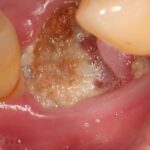
Bisphosphonates have been in use since the 1960 for treating a range of conditions (e.g. bone metastases, lung cancer, multiple myeloma, Paget’s disease). 2003 saw the first cases of osteonecrosis of the jaw linked with patients using pamidronate or zoledronate. Clinically patients have areas of necrotic bone exposure of variable size. Osteonecrosis is associated with pain dental mobility unrelated to periodontal diseases, trauma, or other injuries. Treatment focuses on pain relief, control of infection an arresting bone exposure.
The aim of this review was to determine the frequency of osteonecrosis of the jaw in bisphosphonate users undergoing dental interventions.
Methods
Searches were conducted in the Medline, Embase Web of Science, Scopus, Virtual Health Library, and Thesis Bank of the Coordination for the Improvement of Higher Education Personnel (CAPES) OpenGrey and the Grey Literature Report databases. Randomised clinical trials (RCT) and observational studies (cohort, case–control, cross-sectional studies, and case series) were considered. Outcomes included frequency of osteonecrosis of the jaw described in relation to dental procedures, route of administration of bisphosphonate, bisphosphonate used, and indication for use of bisphosphonate. Two reviewers independently selected studies, extracted data and assessed risk of bias and random effects meta-analyses conducted.
Results
- 27 studies (2 RCTs, 12 Cohorts, 2 cross -sectional and 11 case-series) involving a total of 5291 patients were included.
- Patients were mainly female and aged between 63.8 to 73 years of age.
- Bisphosphonate use was for cancer (11 studies) and osteoporosis (15).
- Dental extraction was the most common dental procedures (22 studies.)
- 19 studies involved alendronate and 17 studies zoledronate.
- 15 studies were considered to be of moderate-high quality and 12 of low quality.
- The pooled frequency of osteonecrosis of the jaw in bisphosphonate users having dental procedures = 2.7% (95%CI: 0.9 to 5.2%) [27 studies].
- For intravenous bisphosphonate = 6.9% (95%CI: 0.7 to 17.3%) [10 studies].
- For oral bisphosphonate 0.2% (95%CI: 0.0 to 1.0%) [14 studies].
- The frequency of osteonecrosis of the jaw in bisphosphonate users who underwent tooth extraction = 4.1% (95%CI: 1.5 to 7.7%).
- No association between longer treatment duration and greater frequency of osteonecrosis was observed.
Conclusions
The authors concluded: –
Higher frequency of osteonecrosis was observed in intravenous bisphosphonate users submitted to dental extraction. Further studies collecting more detailed information on the bisphosphonates used and of greater methodological rigor are warranted to confirm these findings and better inform prescribers, dental surgeons, and other professionals on risks of bisphosphonate use in this patient group.
Comments
The authors registered the review protocol on PROSPERO and followed a standard review methodology. A good range of primary databases and grey literature sources were searched with a broad range of study designs being included. The findings show that the pooled frequency of osteonecrosis of the jaw in in bisphosphonate users having dental procedures of 2.7% (95%CI: 0.9 to 5.2%) being higher in those having dental extractions 4.1% (95%CI: 1.5 to 7.7%) and in those receiving intravenous bisphosphonate 6.9% (95%CI: 0.7 to 17.3%). However, it would have been interesting to see a subgroup analysis based on the quality of the studies as almost half of the included studies used methodological approaches that have greater risk of bias. The review authors also highlight a lack of detailed information in many of the included primary studies. Consequently there is a need for high quality well conducted and reported prospective studies that provide more information of the risks of osteonecrosis posed by the type of bisphosphonates, dosages and duration of use.
Links
Primary Paper
Martins LHI, Ferreira DC, Silva MT, Motta RHL, Franquez RT, Bergamaschi CC. Frequency of osteonecrosis in bisphosphonate users submitted to dental procedures: A systematic review. Oral Dis. 2021 Aug 17. doi: 10.1111/odi.14003. Epub ahead of print. PMID: 34402147.
Other References
Dental Elf – Osteonecrosis blogs
Picture Credits
By Coronation Dental Specialty Group – Own work, CC BY-SA 4.0,
